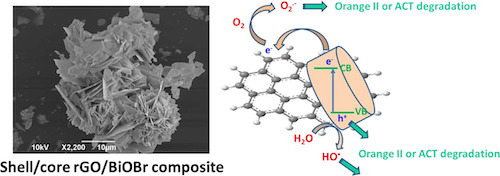Ask for a reprint
email :
* Give your email
2019
ACL
|
Lakhdar Allagui, Bilel Chouchene, Thomas Gries, Ghouti Medjahdi, Emilien Girot, Xavier Framboisier, Abdesslem Ben haj Amara, Lavinia Balan, Raphaël Schneider, 'Core/shell rGO/BiOBr particles with visible photocatalytic activity towards water pollutants', Appl. Surf. Sci. 490 580-591 (2019) doi:10.1016/j.apsusc.2019.06.091
A series of heterostructured photocatalysts associating reduced graphene oxide (rGO) and BiOBr sheets with exposed {001} facets were prepared via a hydrothermal method. TEM experiments demonstrate that rGO deposits at the surface of BiOBr sheets to yield shell/core rGO/BiOBr particles. Under visible light irradiation, the rGO (1%)/BiOBr photocatalyst exhibits the highest activity for the degradation of the Orange II dye and for the removal of acetaminophen. This originates from the increased visible light absorption and from the effective separation of charge carriers in rGO/BiOBr composites. Investigations into the photocatalytic mechanism show that holes in the valence band of BiOBr and superoxide O2− radicals generated by the photocatalyst are the main species responsible for the oxidation of acetaminophen. The rGO (1%)/BiOBr catalyst was also demonstrated to be of high stability, further highlighting its potential for practical photocatalytic applications.
|

|